Time Travel Research Center © 2005 Cetin BAL - GSM:+90 05366063183 - Turkey / Denizli
The warped universe of relativity theory
| The awesome power of the atomic
bomb Einstein's theory of relativity led to
the creation of incredibly powerful nuclear weapons, the destructive
capabilities of which have changed the face of world politics. But it
also gave us nuclear power, which now accounts for a fifth of all the
world's electricity. |
Riding a light beam back in time
Einstein loved to devise "thought experiments" to help him understand the consequences of his ideas, and it was such an experiment that triggered his insights into space and time. He is standing next to a clock, and just at the moment its hands show 12 he is whisked off on a beam of light at 300,000 kilometres a second for 300,000 kilometres. According to common sense, his journey will have taken one second. And if Einstein looks at a watch in his hand, it will indeed say one second past 12. But if he could take a look over his shoulder, the clock back at base would still say precisely 12. The reason is simple: as Einstein is travelling at the speed of light, the light rays transmitting the image of the clock with the new time of one second past haven't been able to catch up with him - while he travels at the speed of light, it will always seem to be 12 precisely. Who is right? The answer is "both" - everything, including time, is relative, and what you measure as time depends on how fast you are moving. Time "slows down" the faster you go. |
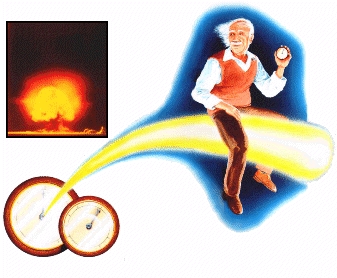 |
|
| When the young Einstein imagined what it would be like to ride on a light beam, he took us all on a fascinating tour .But how much does his thinking explain about the universe now? | |
The theory of relativity: dreamt up by Einstein, and comprehensible only to geniuses. That's the perception But it's a myth. Anyone can understand the basics of the theory it lust took a genius to invent it in the first place.
Today, scientists such as Professor Stephen Hawking regularly use Einstein's
theory in their search for the key to the origin of the universe. But
Einstein's discoveries have a direct impact on all our lives. The post Cold
War world is being shaped by those who have nuclear weapons - whose origin
and power lie in that most famous equation of relativity E = mc2.
Nuclear power, another spin- off from Einstein's theory, now accounts
for a fifth of the world's electricity. Scientists are trying to go one
better and bring nuclear fusion, the power source of the sun and stars, down
to earth. Able to turn a kilogram of hydrogen isotope "fuel" from sea-water
into the energy equivalent of 7000 tonnes of oil, fusion could solve our
energy problems - courtesy of E = mc2.
| Mapping the brain
Positron emission tomography (PET) scans locate brain tumours without surgery. The positron was only discover thanks to relativity. |
Even hospital patients benefit from relativity, in the form of positron
emission tomography (PET) scanners, which are used to perform brain scans.
The existence of positrons - the "antimatter" versions of electrons - was
completely unknown until the 4920s when Paul Dirac combined
Einstein's theory with ideas about electromagnetic waves such as light.
Relativity may now be one of the foundations of modern physics, but it took
years for mainstream scientists to take seriously relativity's implications
- such as the ability of time to slow down, mass to increase and objects to
shrink the faster theytravel. Some scientists never could, or would, accept
them.
Yet for Einstein these implications were just the beginning. They became
part of the theory of "special relativity", which deals with objects
moving at constant speed relative to one another. That was in 1905. Then in
1915 Einstein published his theory of "general relativity" (GR),
which deals with the more widespread or general case of objects that are
changing speed relative to one another.
Nintely years on,cracks are beginning to appear in relativity
GR led Einstein to an astonishing new conception of gravity. According to his theory, this familiar force is actually the result of the curving of the very fabric of space and time by mass - a little as a large sheet of rubber would curve if a cannonball were placed upon it.
General relativity, and its application to the entire universe, made
Einstein famous; but, 90 years on, cracks are starting to appear.
Observations of distant galaxies seem to suggest that the universe is
younger than some of the stars in it. This implies that something is missing
from general relativity.
A vital clue comes from the fact that Einstein's view of gravity fails to
incorporate anything from quantum theory, the laws of the sub-atomic world
which are better supported by scientific evidence even than relativity.
To date, nobody has managed to successfully combine Einstein's vision of
gravity with quantum theory. Who will make the next breakthrough?
Budding Einsteins should start here.
Special theory of relativity
E = mc2 it is the most famous equation in the whole of science.
Its symbols imply that there's enough energy (F) locked up in the mass (m)
of a kilogram of matter to power a house for a million years. It underpins
the power of the sun and stars - and nuclear weapons.
Of all of Einstein's achievements, this equation is the most impressive. Yet
its origins lie in a simple question which the 16- year-old Einstein asked
himself: what would it be like to ride on a light beam? Einstein had a knack
of setting himself riddles that went right to the heart of problems. The
fantastical ride on a light beam is no exception: it led him to develop
relativity.
Weird things clearly happen when you travel at the speed of light - things
that defy everyday experience, like time standing still. But,
most importantly, Einstein's riddle shows that the speed of light has a very
special significance: it is the fundamental speed at which information
travels around the universe.
This special status for the speed of light had already been suspected by the
Scottish scientist James Clerk Maxwell. During the 1860s, Maxwell
wrote down mathematical equations for the behaviour of electricity and
magnetism. One of these equations suggested that the speed of
electromagnetic waves - including light - was a fundamental constant, a law
of physics which has the same value for everyone, all the time.
| Fanning the
fires of nuclear fusion Static electricity weaves a crackling web over the coolant of a particle beam fusion accelerator. The beams hammer a pellet made from deuterium and tritium with five trillion watts per square centimetre, collapsing it in a nuclear fusion reaction. The accelerator, at Sandia Laboratories, New Mexico, is the only one in the world. |
This sounds innocuous enough until you think about it. Then it hits you:
how can the speed of light be the same for everyone? Obviously, the relative
speed of a train depends on how fast you are moving yourself. If you are on
the platform, the speed may be 200 km/h, but to a car travelling on a road
alongside the track, its speed might appear to be just 90 km/h.
The puzzle over the speed of light deepened during the 1880s, following
experiments by the American Albert Michelson, who tried to measure
how much the earth's own speed affected the speed of light. Investigating a
now-discarded theory of how light travels, Michelson thought a light beam
fired at a mirror in the direction of the earth's orbit should be affected
by the earth's movement. A beam fired at right angles to the earth's motion,
however, would have a different relative speed. After many attempts neither
Michelson nor anyone else found any difference: the speed of light seemed to
he constant, the same whether with or against the earth's motion.
The changes in time and length caused by velocity cancel out at the speed of light
Around the turn of the century, scientists came up with all manner of
theories to explain this "crazy" answer. Two professors, Hendrik Lorentz of
Holland and Ireland's George FitzGerald, even claimed that the cause was the
result of half of the Michelson apparatus shrinking relative to the other.
Incredibly, Einstein showed that they were right - but for the wrong reasons.
FitzGerald and Lorentz pinned the blame on molecular change inside
Michelson's apparatus. Einstein showed that the "shrinkage" stems from an
apparent need to keep the laws of physics - including the speed of light the
same for all observers.
But how to explain this "need"? Put simply, time itself is relative
and depends on how one is moving: moving clocks run slower than stationary
ones . Similarly, relative lengths depend on speed too: moving rulers shrink
relative to stationary ones.
The clever thing is that these two effects of speed - on time and on length
- together cancel out any difference in the speed of light. So no matter how
fast you travel the speed of light remains the same. Similar arguments lead
to the conclusion that relative mass also increases with speed. But isn't
this just some sort of trick? Are the shrinkage and the time-stretching real?
Yes, and they have even been measured.
At ordinary speeds, these strange effects are not noticeable, and "common-sense"
results prevail. At earth's speed round the sun (110,000 km/h) the
difference amounts to just five parts in a billion - which would have been
just detectable using optical instruments available to Michelson.
However, scientists have long had access to objects that routinely travel at
very close to the speed of light: sub-atomic particles. Just three years
after Einstein put forward his theory, the German physicist Alfred Bucherer
showed that electrons really do gain mass as their speed increases.
More sophisticated experiments in the 1960s and 1970s using giant "atom
smashers" like the machines at CERN in Geneva, confirmed Einstein's other
predictions. These showed that fast-moving protons behave like flattened
discs rather than tiny spheres when they smash into stationary protons,
demonstrating the shrinkage effect of speed. Unstable particles known as
muons survive longer when moving near the speed of light - an effect that
explains how these particles, which have a half-life of just two-millionths
of a second, can penetrate further into our atmosphere than the 600 metres
predicted by " common sense".
We don't know how to get at more than a fraction of the energy locked in matter
Yet these are not the most dramatic consequences of Einstein's theory;
that comes from the effect of relativity on energy. Einstein showed that if
the laws of physics are the same at all speeds, energy due to speed -
kinetic energy - is really only part of the "total energy" an object
possesses. According to relativity, all objects have an amount of energy
that depends only on their mass. To be precise, this energy (E) is given by
the mass (in) times the speed of light squared: E = mc2.
In theory, just one kilogram of material could be converted into as much
energy as a nuclear power station produces in three years. Unfortunately, in
reality there is no way to extract more than a tiny fraction of the total
energy locked in mass.
Not that this fraction is not dramatic. For example, when the nuclei of
lightweight atoms like hydrogen are fused together in intense heat - as in
the centre of the sun - a small proportion of the mass of the end-product is
converted in energy, via E = mc2. Because the speed of light (c)
is such a huge quantity -300 million metres per second - this means the sun
can emit energy equivalent to the detonation of 100 billion H-bombs every
second for ten billion years.
But the famous equation has its dark side: an H-bomb as small as a car
can produce the explosive equivalent of a million tonnes of TNT. However,
weapons experts are discussing the use of nuclear weapons as a means of
protecting the earth from asteroids. Only missiles carrying nuclear weapons
could deflect the impact of space debris. Perhaps, one day, E = mc2
and the theory of relativity may literally save the planet.
Reflections on the speed of light |
| Crucial confirmation that the speed of light is a
constant was provided by an earlier experiment designed to prove the
opposite. In 1887 two American scientists, Albert Michelson (right) and James Morley, built a machine to test James Clerk Maxwell's theory that light propagates through the "aether" - an invisible medium permeating space. If this was the case, the speed of light should be affected by the speed of the Earth relative to the aether. In the experiment two beams of light were reflected back and forth between two pairs of mirrors, one pair parallel to the Earth's orbit, the other at right angles to it. The beams intersect to produce an interference pattern. When the entire apparatus was turned through 90 degrees, the pattern remained unchanged, showing that the speed of light remained constant. |
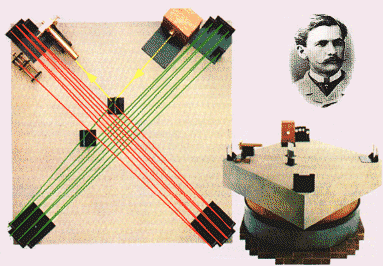 |
| Interfering with the data The cross-shaped "interferometer" (right) had a massive base (below) to prevent the slightest distortion. Despite the results, some physicists suggested the two beams were going at different speeds but the equipment had been compressed by the aether - to the exact extent to make the speeds seem the same. |
General Theory and cosmology
Let go of this magazine, and it falls to the ground. But why? Just saying
"gravity" is no answer - what is gravity? Even the great Isaac Newton had no
clear answer, preferring instead to talk vaguely of some sort of "influence".
It is Einstein and his theory of relativity that provide us with our best
understanding of this most fundamental force in the universe.
Einstein reached his new concept of gravity by widening the scope of his
brilliant "special" theory of relativity. This applies only to things moving
at a constant speed relative to each other. But gravity is a force, and
forces change the velocity of objects. So to understand gravity Einstein
needed a "general" theory of relativity.
A cornerstone of general relativity (GR) is the same idea that led Einstein
to special relativity: the laws of physics must be the same for everyone.
But Einstein needed another brilliant insight - like his imaginary ride on a
light beam - to help him push beyond the limits of special relativity. It
came to him in November 1907 in the Berne Patent Office, where he was an
inventions examiner.
| Trainee astronauts experience "zero-g" in an
aircraft flying so that its acceleration cancels the effect of gravity. |
He suddenly realised that someone free-falling is not aware of the force of
gravity. Imagine you're in a lift when the cable breaks: you're in free-
fall. Now imagine taking a set of keys out of your pocket and letting them
go: they will just stay where they are - relative to the free-faller (ignoring
air- resistance, of course). For the free-faller, it's as if the force of
gravity has been switched off. Einstein realised he could exploit this fact,
which had been known from the time of Galileo: objects, no matter what their
mass, accelerate at the same rate under gravity. This enabled him to cancel
out the local effect of gravity and use special relativity again. But it had
to work everywhere, not just locally.
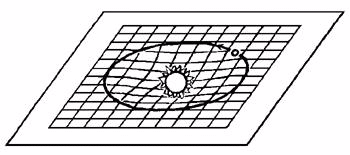
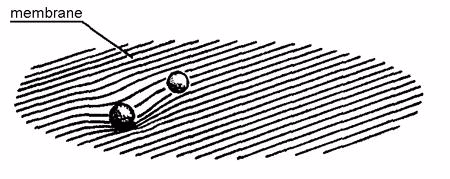
Einstein then discovered something surprising. The failure of special relativity in the presence of gravity is the result of gravity curving space and time. This led to a new concept of gravity. Instead of a vague influence by which. for example, the sun holds the earth in place, relativity led to the image of the sun sitting in space and time and curving both, like a cannonball on a rubber sheet. The earth's orbit follows the contours of this dip.
| X marks the spot Gas and dust - the X shape in the middle - are dragged into a black hole in the Whirlpool galaxy. Space-time is so distorted not even light escapes |
It took Einstein eight years to reach his new theory of gravity. But the
rewards were vast. Newton's law emerged from GR as merely a special case,
true only for relatively feeble gravitational fields and low speeds.
In strong fields and at high speeds, GR starts to show its mettle - as
Einstein quickly showed. Since 1850, astronomers had been baffled by the
behaviour of the planet Mercury, whose orbit refused to obey Newton's law,changing
each year by a tiny amount. Observations of the planet's position were in
error by the equivalent of the width of a pin at 300 paces. Einstein showed
that GR could account for this discrepancy by the fact that Mercury is so
deep inside the intense gravitational field of the sun.
Using GR, Einstein predicted that the warping of space and time by the Sun's
gravity would bend the light of stars out of their predicted position, again
by a tiny amount (equivalent to the width of a pin 60 metres away). Newton
had predicted half the amount.
How the sun bends space,time and light |
|
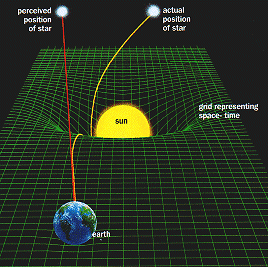 |
Although our sun is an ordinary star, and not a
massive black hole, it distorts space-time into a "gravity well". As the
sun moves against the background of fixed stars, their positions seem to
move slightly. The effect is tiny - less than a thousandth of a degree -
and is caused by gravity bending light. Light from the sun appears to be
coming from a slightly different direction. It is bent because it
follows a curving path across the sun's space-time "dimple", instead of
the straight line it would follow in gravitationally undistorted space. |
In May 1949, two teams of British astronomers measured star positions
during a total eclipse of the Sun visible from Brazil. Einstein correctly
predicted five ten-thousandths of a degree of bending; again, Newton's
theory predicted only half that. This triumph marked the end of Newton's
reign as principal authority on gravity - and Einstein's elevation to
Greatest Scientist of the Century.
He was lucky, though: an arithmetical blunder years earlier had originally
led Einstein to reach the same light-bending value as Newton. A world war
and bad weather had stopped scientists checking out the faulty prediction.
The most impressive consequences of GR were yet to come, however. GR is our best theory of gravity, and gravity is the force that rules the universe. That makes GR the best theory we have for understanding the past, present and future of the universe. Einstein's equations predicted the universe expanding, but in 1916 he, like everyone else, believed the universe to be infinite and unchanging. So he fiddled his equations to fit this view.
By 1929, astronomers had proved Einstein wrong: the universe does
expand. He allegedly described the fiddle factor as the biggest blunder of
his life. Yet, as Focus reported last December, astronomers are now
baffled by new observations of distant galaxies, which seem to show that the
universe is around seven billion years younger than some of the stars it
contains. Einstein's "fiddle factor" - which can be used as a cosmic force
countering gravity - can resolve this situation.
| Hunting down gravity Professor Massimo Cerdonio (above) is building a gravity wave detector (left) to pick up gravitational echoes from supernova explosions. These waves should cause vibrations less than a billionth of a billionth of a metre in size. |
A race is now under way to find "gravitational waves", feeble ripples in
space and time which GR predicts are sent out by huge stellar explosions.
Some scientists hope to detect these ripples by picking up wave-like changes
in the length of huge metal bars. As gravity is a weak force, such changes
may be just one millionth of the diameter of an atomic nucleus. A Nobel
prize probably awaits the winner of this race.
There is, however, one outstanding problem with Einstein's theory.
Scientists now believe there are four fundamental forces at work in the
universe: two nuclear forces, electromagnetism and gravity. The first three
forces come under the banner of quantum theory, in which all forces are the
result of subatomic "exchange" particles jumping from place to place. But
gravity does not fit this scheme.
Attempts to marry Einstein's idea of gravity as space-time curvature with
quantum theory are unlikely to succeed until the next century. And no one
person is likely to achieve as much as Einstein did all those years ago as a
lowly patent clerk in Switzerland. ( Yazar: Robert Matthews )
Gravity and light
Einstein was very lucky because data that fit predictions of
his new mathematical model was observed in light from stars a solar
eclipse in 1919, very soon after his model became public. The
deflection of light around the Sun was one such predictive success
of General Relativity.
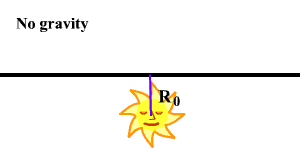
The figure to the left shows three different possible (mathematical) paths
for a pulse of light travelling around the Sun: the path with no
gravity, the path as predicted by Newtonian gravity, and the
path as predicted by Einstein's General Theory of Relativity.
The deflection angle df tells us how far
away from a straight line the path of the light pulse in question was
deflected by the Sun. The deflection angle is by definition zero when
there is no gravity. We need to compare the deflection angles calculated
using the Newtonian and relativistic models for gravity and spacetime.
The turning point R0 is the closest distance that the
light pulse gets to the Sun. We'll standardize our coordinate system so
that f=0 corresponds to R = R0,
and calculate df that way.
No gravity
Without gravity, both Newtonian and relativistic models say the path is a straight line. The path of a straight line in polar coordinates centered at the center of the Sun would be:
1/r = (1/R0) cos(f)
where R0 is the turning point mentioned above. First we want to find Df, which is the total angle swept out by the light pulse from the start to the end of its journey across spacetime. Look at the figure to the left and imagine the straight line path extending infinitely far to the right and left of your screen. When r = infinity, by symmetry of our coordinate system we have
0 = (1/R0) cos(Df/2).
Therefore Df = p is the total
difference in angle swept out by the light pulse as it comes in from
infinitely far away and travels back out infinitely far away.
The deflection angle here is df = Df - p = 0,
as it should be for a straight line.
Newtonian gravity
Newtonian gravity doesn't work well for describing the properties of light, which can be modeled like the propagation of a massless particle. But it is possible to fake it by using the equation for a Newtonian hyperbolic orbit:
1/r = (G M(m/L)2)(1 + e cos(f)), e = (1 + (2E/m)(L/GMm)2))1/2
where the eccentricity e is a function of the incoming
particle's energy E, mass m and angular momentum L.
The turning point R0 = (L/m)2/(G M (1 + e)).
If we want to fake the propagation of light in Newtonian gravity, we can
set the energy E = m v2/2 = m c2/2 so that
(2 E/m) = c2. The angular momentum per unit incoming
mass (L/m) becomes L/m = R0 c. The total
angular sweep Df = p + df is given by
0 = (1/R0) cos(Df/2) + (G M/c2)/R02,
- cos(p/2 + df/2) = sin(df/2) ~ df/2 = (G M/c2)/R0
so finally dfN = 2 (G M/c2)/R0 is the deflection angle for light found by naively using the Newtonian model for a particle with velocity c.
Einstein's General Theory of Relativity
In General Relativity, the path of a light pulse is described as a null geodesic satisfying the geodesic equation for the Schwarzschild metric, the distance function that solves the Einstein equations around a massive object in outer space such as the Sun. An approximate equation for the trajectory is
1/r = (1/R0) cos(f) + ((G M/c2)/R02) (2 - cos2(f)).
The term cos2(f) can be neglected if the deflection angle df is very small and Df/2 is close to p/2. Therefore, to lowest order in df we get
0 = (1/R0) cos(Df/2) + 2 (G M/c2)/R02,
- cos(p/2 + df/2) = sin(df/2) ~ df/2 = 2 (G M/c2)/R0.
Therefore dfE = 4 (G M/c2)/R0 = 2 dfN is the deflection angle for light found by using null geodesics in the Schwarzschild metric according to General Relativity.
Observations of starlight deflected around the Sun were made during solar
eclipses beginning in 1919, and the measurements supported Einstein's
model, not Newton's which predicts an angular deflection of half the
size that was observed.
Hiçbir yazı/ resim izinsiz olarak kullanılamaz!! Telif hakları uyarınca bu bir suçtur..! Tüm hakları Çetin BAL' a aittir. Kaynak gösterilmek şartıyla siteden alıntı yapılabilir.
The Time Machine Project © 2005 Cetin BAL - GSM:+90 05366063183 -Turkiye/Denizli
Ana Sayfa /
index /Roket bilimi /![]() E-Mail /CetinBAL/Quantum Teleportation-2
E-Mail /CetinBAL/Quantum Teleportation-2
Time Travel Technology /Ziyaretçi Defteri /UFO Technology/Duyuru